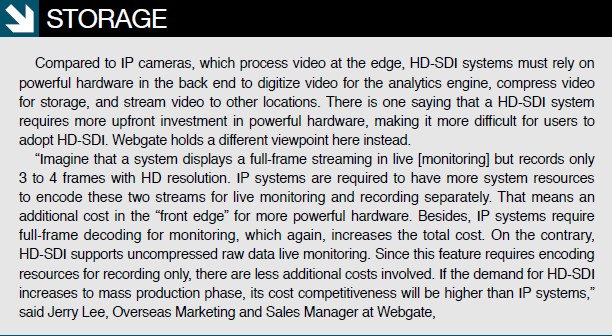Today, some manufacturers already allow PTZ control and bidirectional audio. This creates the foundation for traditional matrix manufacturers to make their comeback in a world of HD video surveillance. Functions are still a bit lacking at the moment, and the scale is limited to 96×16, but things are moving forward quickly. However, it is important to note that one should avoid planning purchases based on promised features.
Today, some manufacturers already allow PTZ control and bidirectional audio. This creates the foundation for traditional matrix manufacturers to make their comeback in a world of HD video surveillance. Functions are still a bit lacking at the moment, and the scale is limited to 96×16, but things are moving forward quickly.
However, it is important to note that one should avoid planning purchases based on promised features.
Image Processing and Analytics
Although SDI advocates tout zero latency, HD-SDI actually has a delay of 40 to 50ms. To be fair, that level of latency is not noticeable to the naked eye. In terms of image quality, HD-SDI's lossless pictures provide pure distortion-free, no-lost-frames bliss. Low SNR and wide dynamic range allow HD-SDI to produce relatively better images, compared to network cameras.
When it comes to video analytics, accuracy is greatly improved since there are no lost frames or distortion in the picture. HD-SDI is currently limited to basic analytics such as masking, motion detection and OSD, while features like people counting are not yet possible. Chipmakers have already announced analytics-enabled 1080p30 chips, but it may be a while before actual products materialize.
Having said that, it is important to remember that with great picture quality, comes great processing requirements. "Whether it is analytics via HD-SDI or IP, the more details you feed the analytics engine, the more accurate result you will get," said Wang Jin Ze, SDI Product Manager, Tiandy Digital Technology. "However, as the pictures increase in quality, so will the required resources for processing those pictures. In that sense, HD-SDI does not necessarily have a decisive advantage over IP when it comes to analytics."
Central Processing
The central processing approach consolidates the resources for N channels in one location, taking maximum advantage of Moore's Law improvements in chips, according to Todd Rockoff, Executive Director, HDcctv Alliance. In contrast, there are two fundamental disadvantages of the network camera approach, according to Rockoff.
The first is that network cameras each have at least one compression subsystem. "That's at least 17 chips (including the NVR) in an IP camera system, versus as few as one chip in an HDcctv DVR."
The second is that "compression is required in modern surveillance systems for streaming to three destinations: local-site storage, off-site live views, and off-site storage," Rockoff continued. "DVRs are also efficient for streaming playback to off-site locations." DVRs have been proven cost-effective for these four purposes, Rockoff said.
In contrast, Rockoff said, network camera-based system architecture introduces a further requirement of compressing for live view in the camera. "A single, compressed stream emerging from the camera is very likely to be less than optimum for at least one of the four purposes. Countering this issue by storing in the camera and/or producing multiple streams serves to increase camera complexity and consume more local-site IP LAN bandwidth, both of which are precious resources.”
